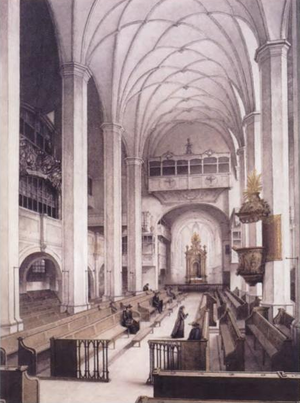Ich freue mich in dir, BWV 133 facts for kids
Quick facts for kids Ich freue mich in dir |
|
|---|---|
| Chorale cantata | |

Thomaskirche, Leipzig 1885
|
|
| Occasion | Third Day of Christmas |
| Performed | 27 December 1724: Leipzig |
| Movements | 6 |
| Vocal | SATB choir and solo |
| Instrumental |
|
Ich freue mich in dir (which means "I rejoice in You" in German) is a special piece of music called a church cantata. It was written by the famous composer Johann Sebastian Bach. This cantata, also known as BWV 133, is a type of Christmas cantata. Bach created it in Leipzig in 1724 for the Third Day of Christmas. It was first performed on December 27, 1724. This chorale cantata is based on a hymn written by Caspar Ziegler in 1697.
Contents
History of the Cantata
Bach wrote this chorale cantata during his second year as the Thomaskantor (music director) in Leipzig. It was part of his second series of cantatas, known as Bach's second cantata cycle. He composed it for the Third Day of Christmas.
The Original Hymn
The cantata is based on the four-part hymn "Ich freue mich in dir" from 1697. This hymn was written by Caspar Ziegler. It was one of the newer hymns Bach chose for his second annual cycle. Usually, Bach preferred older, well-known hymns by poets like Martin Luther and Paul Gerhardt.
An unknown writer adapted Ziegler's hymn for Bach's cantata. This writer kept the first and last parts of the hymn. They changed the middle parts into a mix of recitative (like spoken singing) and aria (a song for one voice). The words of the cantata express a deep, personal joy about God being present in the baby Jesus.
First Performance
Bach first performed this cantata on December 27, 1724. Years later, after Bach passed away, his successor as Thomaskantor, Gottlob Harrer, also performed the cantata.
The Original Score
The original handwritten music (called the autograph manuscript) for this cantata was once thought to belong to Bach's son, Wilhelm Friedemann Bach. In 1827, it was sold at an auction in Berlin. The famous composer Mendelssohn was asked to help organize the materials for this auction. Because of his help, Mendelssohn was given the original score of BWV 133 as a gift.
Music and Structure
This cantata has six different musical parts, called movements. It is written for four solo singers: a soprano (high female voice), an alto (low female voice), a tenor (high male voice), and a bass (low male voice). It also features a four-part choir (singing group).
Instruments Used
The instruments used in the cantata are:
- A cornett (an old wind instrument)
- Two oboes d'amore (a type of oboe)
- Two violins
- A viola
- And a basso continuo (a group of instruments that provide the bass line and harmony, usually a cello and a harpsichord).
The Movements
Here are the six movements of the cantata:
- 1. Chorus: Ich freue mich in dir (The choir sings the main hymn melody)
- 2. Aria (alto): Getrost! es faßt ein heil'ger Leib (A solo song for the alto voice)
- 3. Recitative (tenor): Ein Adam mag sich voller Schrecken (A spoken-like part for the tenor voice)
- 4. Aria (soprano): Wie lieblich klingt es in den Ohren (A solo song for the soprano voice)
- 5. Recitative (bass): Wohlan, des Todes Furcht und Schmerz (A spoken-like part for the bass voice)
- 6. Chorale: Wohlan, so will ich mich (The choir sings the final part of the hymn)
Musical Details
The main hymn melody in the first movement is based on a different tune called "O Gott, du frommer Gott". Bach likely learned this melody around the same time. He even used it in his famous Mass in B minor.
In the first movement, the cornett plays the main melody (called the cantus firmus) along with the soprano singers. The oboes play with the second violins and violas, while the first violins play a brighter, more prominent part. The lower voices in the choir mostly sing together in a simple, block-like style called homophony.
The conductor John Eliot Gardiner said that the opening chorus of BWV 133 "conveys more persuasively the essence, the exuberance and the sheer exhilaration of Christmas" than almost any other music.
The alto aria is accompanied by the two oboes d'amore. The soprano aria is accompanied by the strings (violins and viola). This soprano aria changes its rhythm in the middle section to a gentle, flowing style called a siciliano.
The tenor recitative slows down twice. This happens when the words talk about "Almighty God Himself here visits us" and when it quotes the hymn, saying "He has become a little child and is called my little Jesus." The cantata ends with the choir singing the last part of the hymn in four voices.
See also
 In Spanish: Ich freue mich in dir, BWV 133 para niños
In Spanish: Ich freue mich in dir, BWV 133 para niños

